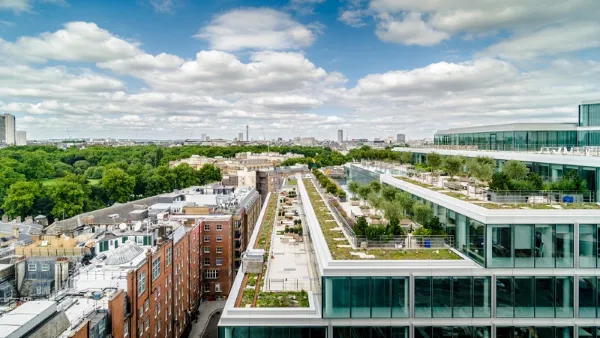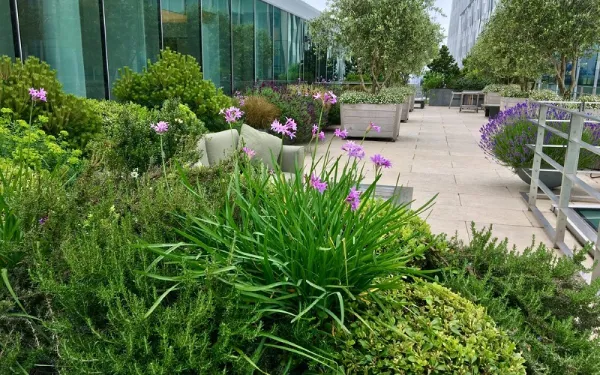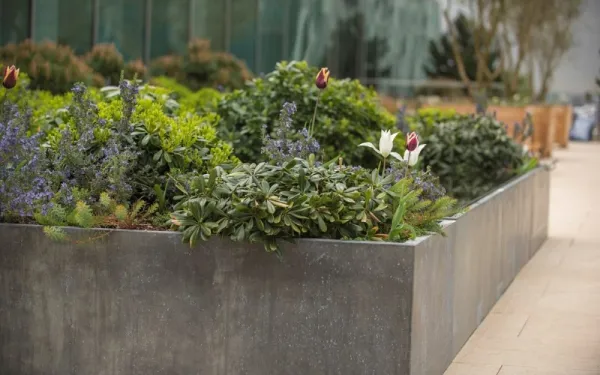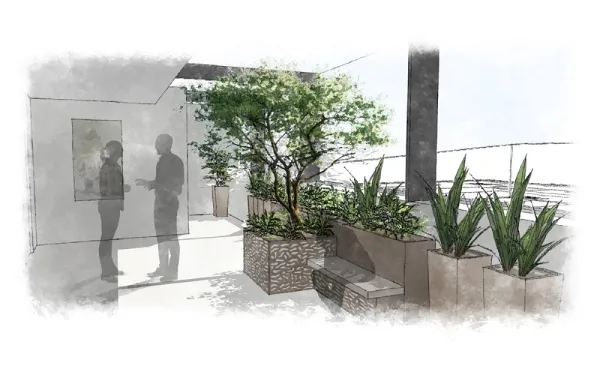The Covid-19 pandemic has brought with it changing working arrangements, priorities and values – especially when it comes to office spaces. Office developments are now placing even more value in creating green spaces to meet the increasing demands of employees and tenants.
Everybody is asking the same question: ‘How will COVID19 change everything in the long-term?’ In other words, which trends are temporary and which permanent? We have noticed that the most obvious effects are when two or more trends that were already in evidence before COVID, have been accelerated and combined to give a noticeable shift.

About six years ago, it became clear that developers of office space were becoming more interested in enhancing their product with landscape. By improving the outside environment, they were able to boost the rental value and saleability of their product. In one case, a developer sacrificed lettable office space to add roof terraces – and in doing so, raised the overall yield. They then went one step further, completely repackaging the development as ‘Verde’ and marketing it as ‘The Park in the Sky’, giving them a significant competitive advantage over neighbouring developments. Not only did the development appeal to urban planning, but also to the employees who could enjoy a better ‘lifestyle’ in the workspace.
The development of the ‘experience economy’ has been in progress for many years now – essentially a shift in emphasis from goods to experiences. The profusion of nail bars, hairdressers, bars, restaurants, and coffee shops on our high streets is an example of this and partly explains why the UK economy was hit particularly hard by lockdown. Landscape spaces are an ideal environment for these sorts of activities. You only need to look to the success of the Kings Cross area to see this.

In more recent times, the increasing value of green spaces has been driven by pressure from local governments to improve the green infrastructure – witness the GLA (Greater London Authority) seeking an ‘Urban Green Factor’ of 0.3 or above on all new developments. In basic terms, this means that every new development must ensure that at least 30% of its total footprint is dedicated to green spaces.
This has been coupled with social change – employees have an increasing desire to work from home at least some of the time. Increasing congestion on the roads and public transport, teamed with improved remote-working technology has fuelled this desire. The pandemic has also increased our value of nature and green spaces, which for many became a refuge during the uncertain months of the lockdown.
Therefore, we’re seeing a time of change in office spaces. Post lockdown, most organisations seem to want to reduce their office footprint. Economic trendwatchers were saying that there would be a slump in office development and a glut of space. Much of this would convert to housing, with the remainder sitting empty. Some of this may be true, but a different trend is also beginning to appear.

Major occupiers want to keep a presence in the prestigious London scene – take Google as an example. Offices will still be necessary for this type of occupier – tech, financial services, and science are all maintaining or increasing their office take-up in central London. But their new priority is to offer ‘incentives’ to get staff back into the office and away from the home. Google takes this one step further even – they want to make the office environment so good that nobody will want or need to leave the building. Often this works for companies with a younger staff profile, where home-working environments may not be so productive as for more established employees.
Design Director, James Smith, comments ‘Break out areas, yoga spaces, roof-top ‘Urban Farms’, bicycle repair and storage, ‘Walk-and-talk’ meeting routes, restaurants, internal streets complete with trees, eight-storey green walls and winter gardens on the 43rd floor – we have been asked to add all of these (and more) to schemes in the last three or four months.’
He goes on to say, ‘From about April onwards, we saw a surge in enquiries and commissions from property companies wanting to enhance their new developments with innovative green spaces. Companies seem to want to cut back on their office space, but invest more in what they will still have – making it work harder.’

Alongside that, owners of semi-redundant office space are looking to upgrade it through landscape. Older developments are being recycled with investment into more flexible spaces, with more amenities – including higher quality outside spaces to add to the appeal factor.
Both developers and building owners are also becoming aware of the need for a more sustainable approach, both in terms of their own values and their public façade, but also in what prospective tenants are looking for. One thing is certain though, the pile ‘em high, sell ‘em quick era of office development is gone for good. And for landscape and the environment, that can only be a good thing.
For more information: Bowles & Wyer
Bowles & Wyer
Rosa Hinton
01296 662 439
rosa@bowleswyer.co.uk
www.bowleswyer.co.uk
